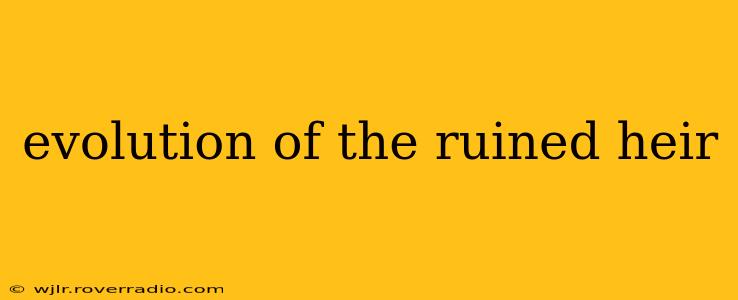The "ruined heir" trope, a staple in fiction across genres, has undergone a fascinating evolution. Initially presented as a tragic figure, often defined by their downfall and associated with pity or disdain, the ruined heir has blossomed into a much more nuanced and complex character archetype. This evolution reflects societal shifts and a growing demand for more realistic and relatable protagonists. This exploration delves into the historical context of the trope, its modern iterations, and the factors driving its transformation.
What is a "Ruined Heir"?
Before exploring the evolution, let's define the archetype. A ruined heir is a character of noble birth or significant wealth who has experienced a catastrophic loss – be it financial ruin, the loss of title, social disgrace, or a combination thereof. This loss is often central to their character arc, shaping their motivations and driving the plot. Early iterations typically depicted these characters as victims, struggling with their fallen status and often relying on external forces for redemption.
The Classic Tragic Figure: Early Representations of the Ruined Heir
In early literature and storytelling, the ruined heir was often a symbol of fallen greatness, a cautionary tale of hubris or misfortune. Think of the prodigal son, a biblical archetype that embodies this trope. Their story evokes sympathy, but ultimately, their redemption relies on external forces – forgiveness and reconciliation. This portrayal largely focused on their suffering and the external forces that brought about their ruin. There was little exploration of their internal struggles or agency in shaping their own destinies.
The Rise of the Anti-Hero: A More Complex Portrait
As storytelling evolved, so did the portrayal of the ruined heir. The rise of the anti-hero in the late 20th and early 21st centuries significantly impacted the trope. Ruined heirs began to exhibit more morally grey characteristics, making complex choices and facing the consequences. Their downfall wasn't always solely due to external forces; internal flaws, bad decisions, and flawed character traits played a significant role. Instead of passive victims, they became active agents in their own narratives, fighting for redemption on their terms.
How has the portrayal of a ruined heir changed over time?
This question reflects the evolution of the trope itself. The change stems from a growing demand for more realistic and multi-dimensional characters. Modern readers and audiences connect with characters who are flawed and relatable, grappling with internal conflicts and making choices with unpredictable consequences. The classic tragic figure, while still relevant in some contexts, has largely given way to a more complex and engaging character archetype.
What are some modern examples of ruined heirs in fiction?
Numerous modern works showcase the evolution of the ruined heir. Examples can be found in books, films, and television series, offering a vast spectrum of interpretations. While specific examples would require careful analysis of individual works, the key takeaway is the increased focus on agency, moral ambiguity, and the exploration of internal conflict rather than simply external forces causing the ruin.
What motivates a ruined heir?
The motivations of a ruined heir are as varied as the characters themselves. In classic depictions, their motivation is often survival and restoration of their former glory. However, in modern interpretations, their motivations might be revenge, self-discovery, the pursuit of justice, or even redemption through unconventional means. The core motivation often stems from their experience of loss and their desire to rebuild their lives, but the how is significantly more complex.
Are ruined heirs always sympathetic characters?
Not necessarily. The evolution of the trope has led to the creation of ruined heirs who are morally ambiguous or even outright antagonists. Their motivations might be selfish, their actions questionable, yet they still retain the core element of their fallen status. This adds layers of complexity and intrigue, allowing for more morally grey narratives and more realistic character portrayals.
Conclusion: Embracing Complexity
The ruined heir trope has traveled a considerable path, moving from a symbol of tragic fate to a complex character archetype capable of driving compelling narratives. Its evolution mirrors the growth in storytelling sophistication, reflecting our fascination with flawed, relatable characters and the intricate struggles they face in their quest for redemption or, perhaps, a different kind of fulfillment altogether. The core of the trope remains – a fall from grace – but the journey toward recovery or acceptance has become far more nuanced and engaging.
